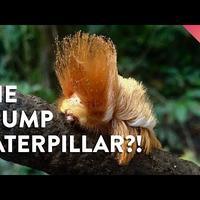This Rainforest Caterpillar Looks Like Donald Trump
One of nature's best tricks for avoiding predators is to not be seen at all.
But some creatures use a different strategy.
They advertise their presence.
[MUSIC]
This is a Megalopygid caterpillar.
We found this one while we were exploring the Peruvian Amazon.
This family of moths has a few common names, but their resemblance to a certain politician's
famous fluff has earned them a special nickname: Donald Trump caterpillars.
The Donald Trump caterpillar loves attention, it wants to get noticed.
It's a confusing strategy: If you don't want to get eaten, why advertise yourself?
Those hairs might look cute and cuddly, but they're disguising irritating, venomous
spines.
Touch it… or eat one… and you're gunna have a bad time.
This caterpillar's showy appearance delivers a clear message to other animals: STAY AWAY.
It's what biologists call an aposematic signal, and nature's full of them.
Like this, or this, or these.
The caterpillar's warning signal works so well that another rainforest resident has
evolved to mimic it.
No, not another caterpillar.
That baby bird.
This cinereous mourner chick will grow up to wear ordinary gray, but the baby looks
more like… carrot-flavored cotton candy?
Predators mistake that orange fuzz for the Trump caterpillar, so they stay away.
It's a detailed disguise too, even the tips of the feather barbs are colored to mimic
those irritating hairs.
But it gets better.
When scientists watched the nest, the bird even moved like a caterpillar when startled.
Mimicry is so useful in fact that some species use it to disguise more than just their own bodies
I'm going to let our rainforest host Aaron explain:
So this is kind of weird, we were hiking in the jungle the other night
and we came across this weird yellow structure on the bottom of this leaf
and at first I thought this was the so-called Donald Trump caterpillar
but this is not one of those caterpillars, it looks a lot like it I think
but this appears to be some sort of egg case, I don't know I've never heard about
an egg case mimicking a venomous caterpillar like this.
But it would make sense, that would be a good way to ward off potential predators
So let's find out, that would be really cool.
Nature plays with a bunch of di fferent copycat strategies, but a harmless species copying
the warning signals of a harmful one is called Batesian mimicry, named after Henry Walter
Bates, an English naturalist who studied alongside Alfred Russel Wallace and Charles Darwin.
Bates loved butterflies, and they're masters of the mimicry that bears his name.
The North American pipevine swallowtail is so toxic that at least six other species of
butterflies and moths wear its disguise.
And instead of one species mimicking another, female African swallowtails mimic more than
a dozen other butterflies, depending on what the local toxic species happens to be, almost
as if they have genetic GPS!
Lucky for this guy, mantises will hunt just about any bug but ants. … except, this isn't
an ant.
It's one of a whole class of ant-mimicking spiders that dress as insects to get protection…
Several caterpillars wear snake heads on their bodies… and this moth even wears a pair
on its wings.
Birds are their main predators, and most birds, either instinctively or by learning from others,
will avoid the danger noodles.
The stripes of a venomous coral snake tells birds “we're off the menu” and that
pattern delivers such a clear message that 1 in 5 New World snake species mimic those
stripes for their own safety.
But they don't get the stripes quite right.
But in mimicry, disguises don't have to be perfect.
They just have to be good enough.
If birds knew the rhyme…
Narrated: “Red and yellow kill a fellow, red and black, venom lack”
…they wouldn't get fooled.
Until they met this venomous South American coral snake.
Nature is full of exceptions, and mimicry is always being refined by evolution.
If you're facing the choice between having dinner and being dinner, it's best to be
cautious rather than confident.
In nature, how something looks can be its making or unmaking.
Scientists like Bates and Darwin knew that mimicry proved the power of natural selection,
even though they didn't understand how an unguided process could copy patterns between
such distantly related species.
Today, more than a century later, scientists are finally unraveling the genetics that draw
these copycats.
So be careful out there.
If it's begging to be noticed, maybe it's best to stay away.
Stay curious.
Did you enjoy all that awesome close-up footage of the Donald Trump caterpillar?
That's from our friends at Deep Look, you might remember them from our video on slime
molds.
They joined us in Peru, so make sure you're subscribed to Deep Look so you can see what
awesome sights they brought back from the rainforest

